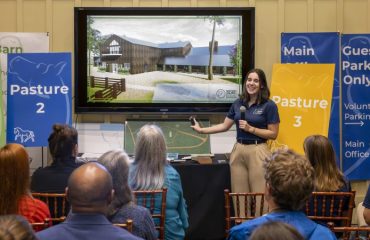By Margie Sugarman
What do Marie Claire, Anne Hathaway, Megan Fox, Kate Bosworth, Lindsay Lohan, Blake Lively,
Madonna and maybe your horse have in common?
Cowlicks and whorls. These terms come from a rather interesting definition: They are nouns that refer to a shape or pattern that is spiral or circular in form. When it comes to people or horses, it refers to a tuft of hair that looks like it has been licked by a cow, out of its natural direction and position. It’s also referred to as a calf-lick. They are commonly seen on equines’ foreheads, but can be found anywhere on their bodies.
It has long been said that one can predict the direction an anxious horse will spin by his facial whorls (also known as rosettes or trichoglyphs). Moreover, these whorls are often related to a horse’s brain development. Whorls form in the fetus at the same time the brain is forming. As observed by Dr. Temple Grandin of Colorado State University, “The nervous system and the skin, which contains the whorl patterns, come from the same embryonic layer.”
A pilot study at Colorado State University, based on 19 horses with whorls, was divided into two groups: horses that had whorls going to the right and those going to the left. The query was to determine if the whorl could predict favoring of direction like right- or left-handed dominance. Indeed, when exposed to stimuli that could be frightening the direction of the whorl predicted the favored side—the side the horse would turn to.
Furthermore, a study in 2008 found that the direction of the whorl impacted the lead a horse naturally picked up. Studies also showed a connection between the location of the whorl and behavior. In equines where whorls are above the eyes but on the forehead, behaviors seem to be less manageable and more excitable than in those with whorls lower on the face. Of interest is a study that found that horses who had double whorls were more successful at the higher levels of equine sports, be it hunters, jumpers or racehorses. Very accomplished show jumpers had double the rate of whorls when comparing them to the general population of horses.
Although the above speaks of the positive implications of whorls, Dr. Grandin performed some other interesting whorl “habit” studies. Her observations found that horses who had whorls in odd places, were of odd shapes or numerous in count were those that showed severe behavioral issues. Her summation: These types of whorls are suggestive of issues with the embryonic brain development. This might be why we find that children and adults with developmental disabilities have a higher incidence of abnormal hair whorl patterns.
Using hair swirls as predictors of horse temperament, ease of training, dependability and reaction to stimuli dates back centuries to the Bedouins and gypsies. However, it was via Linda Tellington-Jones that it became more out in the open in the 1980s and ’90s.
She found:
- A single swirl centered, but below the level of the eyes, indicates a friendly, agreeable nature.
- A whorl centered in the forehead indicates an uncomplicated nature.
- A swirl centered below the eyes indicates an intelligent horse but possibly mischievous.
- Two or more swirls indicate a more complicated personality (but research shows exceptional athletic ability).
The important thing to remember in dealing with horses that have cowlicks, swirls or whorls is to use it as a guide in training. Remember, every horse is an individual.
As Tellington-Jones so aptly stated,“Nowadays we have so many more ways to deal with such horses—to teach them to think instead of react.”













